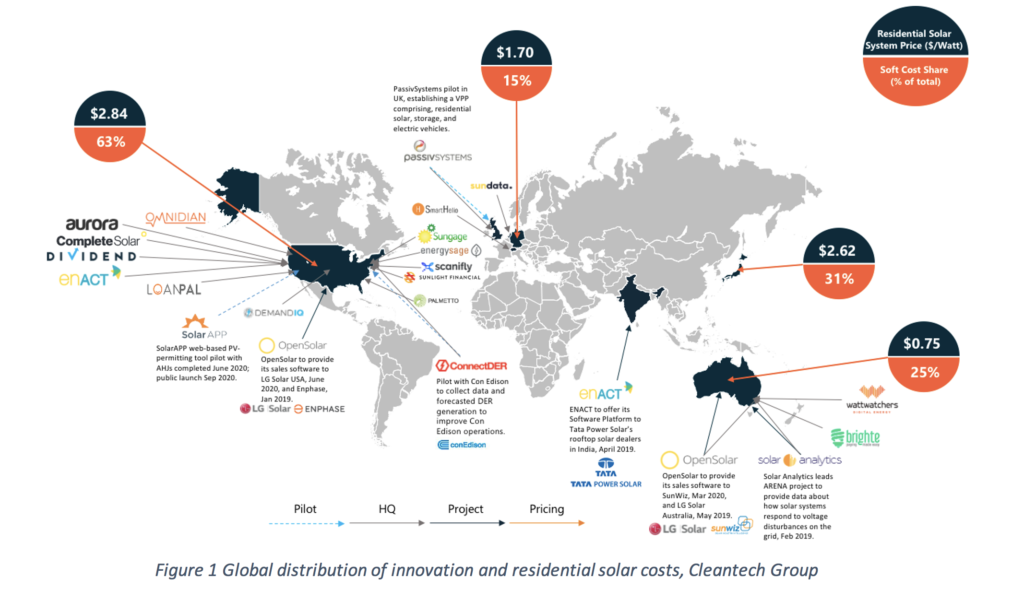Solar Energy for Residential Buildings: The Time is Now
For the past two decades, thousands of entrepreneurs have dived into the residential solar space hoping to become a market leader. Few have accomplished this task, and many have fallen. Today, tens of thousands of active residential solar providers exist globally. However, current trends are pushing a more data-enabled, streamlined value chain, driven by market specialization. As a result, ancillary solutions are challenging the market share and creating consolidation opportunities for vertically integrated residential solar providers.
The residential solar segment includes both single-family homes and multi-family homes. In 2020, the residential solar market was valued at $15.2B and is expected to grow to $26.8B in 2025 at a 12% CAGR. Multi-family home solutions, despite its “residential” definition, are more closely related to commercial and industrial (C&I) solutions than single-family home solutions. For this reason, this article focuses on innovation within the single-family home solar segment, including behind-the-meter (BTM), distributed generation, grid-tied, and rooftop solar systems of sizes 10kW or less for single-family homes.
Despite the maturity of residential solar technology globally, opportunity for innovation still exists for optimizing soft costs and financing as well as operation and maintenance (O&M) costs.
Historical Drivers and Outcomes
Historically, residential solar adoption has been driven by government incentives and the falling hardware costs of solar equipment. Cash subsidies in Australia made 1kW systems virtually free. Feed-in-tariffs and other cash subsidies encouraged early adoption in Europe and, more recently, in Japan. Net-energy metering (NEM) and the investment tax credit (ITC) were key drivers to investment in residential solar in the US. Despite differing strategies, the goal in all markets was to encourage solar adoption by making it as cheap as possible.
As this race to lower costs continues, market consolidation has started to kick off to lower customer acquisition and other soft costs. In the US, the Sunrun and Vivint merger has proved a clear leader of this strategy.
Innovation in the Market Today
Aside from a personal desire to “go-green”, residential solar now has the potential to:
- Save homeowners money
- Be an income producing asset
- Provide energy resiliency.
However, current barriers to large scale adoption include the sales, design, installation, financing, and O&M processes. To knock down these barriers, innovators are developing digitalized products and business models to streamline the sales and installation processes and to provide more value to the long tail.
Soft Costs
Soft costs are the non-hardware related costs of deploying residential solar systems. The US has the highest soft costs of any other country, which is due the cost of customer acquisition, labor, permitting and financing (See Figure 1, below).

Most activity in soft cost innovation is happening in the US because of the country’s high ratio of soft costs to total system costs. The US Department of Energy and National Renewable Energy Laboratory (NREL) view soft costs as the primary challenge to make residential solar more competitive in the US.
Aside from reducing total system expenses, soft cost innovation is attractive because it addresses inefficiencies in the residential solar provider process. Innovative business models aim to streamline the sales process, reduce time spent on site visits, and eliminate change orders.
Soft Cost Business Models
Data integration is allowing sales proposals and systems designs to be created without any physical site visits. Software is using the input data on the backend to create a simplified and largely automated interface and workflow experience. Designers no longer need to be engineers and trucks no longer need to be sent to take rooftop measurements or confirm project status.
- Solar Marketplace: Web-based platforms to educate prospective consumers and provide initial quotes and financing packages (Pick My Solar, EnergySage)
- Customer Onboarding: Gig-economy style sales force (Palmetto) and automated AI sales tools to onboard new solar customers (Demand IQ)
- Remote Site Analysis and Geospatial Data: Integrated rooftop, shading, and climate data to be used for prospecting and system modeling and design
- Drone Imagery Data: Use of drones to provide high quality data to create detailed 3D models of homes and surroundings (DroneDeploy) and to quickly design a solar system for the home’s roof (Scanifly)
- Satellite and LIDAR Data: Use of satellite and LIDAR data to build 3D models of homes and surroundings and software to design solar systems on top of models (Aurora, Sighten) using machine learning to optimize system design (Complete Solar)
- Sales Optimization Software: Toolkit to manage end-to-end process of solar value chain activities and streamline workflow process via SaaS model (Sofdesk, Enact)
Financing
Low system costs and supportive feed-in-tariff (FIT) policies in Europe and Asia Pacific have supported higher penetration levels of residential solar. Self-funding is the most popular form of financing for residential solar projects in Europe, Japan and Australia. In the US, third-party ownership (TPO) models, such as leases and power purchase agreements (PPAs), have been the backbone of residential solar financing because of the higher systems costs. However, in 2018 solar loans financed more systems in the US than leases and PPAs combined.
Financing innovation is concentrated in the US. Innovation is reducing the time spent seeking financing options, providing favorable terms, encouraging direct ownership, and increasing savings over a system’s lifetime. The direct ownership trend is expected to continue as more users are incentivized to follow a prosumer model – someone who both produces and consumes energy.
Financing Business Models
Specific to the US market, point-of-sale lenders have built fintech platforms to make lending simple and easy. Favorable loan terms can be approved in minutes making direct ownership more attractive and accessible.
- Solar Loans: Flexible loan terms and direct ownership status of the solar system allow end users to save two to three times more over the lifetime of the asset (Sungage, Dividend, Mosaic, Loanpal, Sunlight Financial)
Operation and Maintenance
Residential O&M products and services are part of the long tail because of its ancillary position to solar sales and installation. As maturation of the residential solar market continues, O&M solutions are becoming more prevalent. Innovative solutions are data-enabled and focus on both driving down total O&M costs and maintaining system performances.
Data-enabled O&M solutions support both prosumers and large TPO asset managers looking to optimize the performance level of residential solar systems. Prosumers are demanding solutions as systems approach end of life, while direct ownership models are placing O&M responsibilities on end users. Asset managers are looking to squeeze more value out of their assets and optimize O&M fleets.
Operations and Maintenance Business Models
The introduction of technology, including automatic performance detection and computerized remote maintenance management systems, is driving service staff efficiency. Inverter and system level data is identifying fault location, explanation and solution. System digitalization is enabling the potential of smart system technology.
- System Monitoring: Data collection, analytics, and controls for residential solar systems (SolarLog, Solar Analytics, eturnity, SolarView Technologies)
- Predictive Analytics: Identifying system anomalies and recommending action to prevent system defects (SmartHelio, SunData)
- Solar Data Integration: Power electronics act as an enabler for residential solar O&M, removing balance of system components and wiring upgrades. Innovative power electronics (string inverters, microinverters and power optimizers) enable data fidelity for more granular monitoring and analytics, providing data at string and module level (ConnectDER, SPAN, WattWatchers)
- Asset Management Software: Portfolio performance analytics and fleet management toolkit to ensure highest output and lowest downtime (Omnidian, kWh Analytics, AlsoEnergy, PassivSystems)
Challenges for Innovating in the Solar Market Today
Soft costs remain the number one challenge for residential solar. Residential solar relies heavily on in-person services. It is a challenge to adapt services and provide education without spending too much on overhead. The software and toolkits that are being developed to address soft costs have the challenge of building trust with potential adopters. Ninety-eight percent of solar installers visit the project site before construction to verify data. For remote tools to be adopted, they must demonstrate high accuracy.
Regulation and incumbent activity pose other challenges. In California, the new-build solar requirement market is encouraging third-party ownership, imposing challenges for solar loans. Globally, incumbents have been developing in-house software and O&M solutions to support their core product services. Incumbents may pose a deeper challenge as consolidation could drive down soft costs organically.
Keep an Eye On
Residential solar plus storage solutions are becoming widely adopted and will be a key player in driving residential solar growth and innovation. System communication with home energy management (HEM) and storage devices (batteries and EVs) will be the next big development. Solar IOT solutions are being developed to smarten home systems and control aggregation, consumption, and storage activity in relation to rooftop solar production performance. KM
Right now, data enablers are conducting pilots to better understand how residential solar works in VPP systems and how it can be better managed for the multi-family segment. Allume and Resilience Energy are conducting pilots and projects in the US, UK, and Australia to address multi-family energy trading specifically.
The future of energy democratization and localization, globally, is being driven by developments in residential solar, today.


